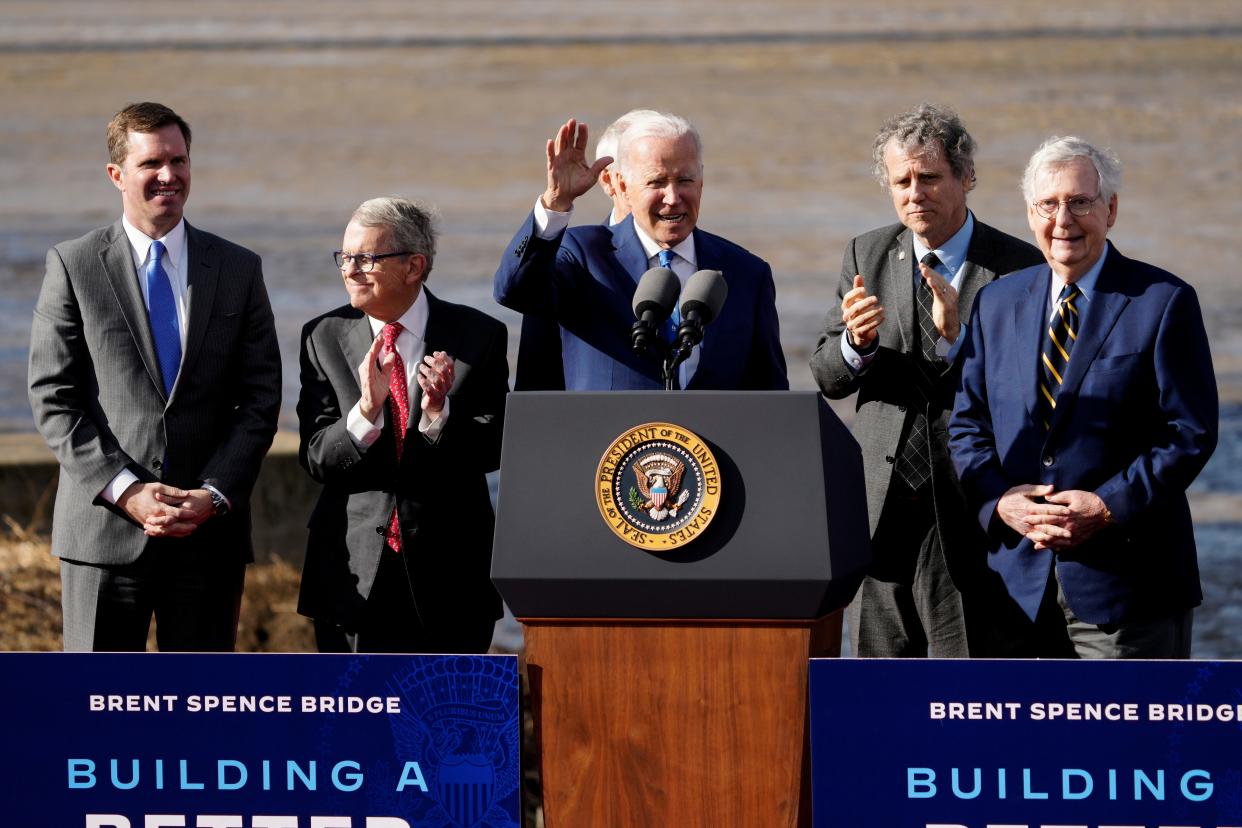'We are making history.' Politicians labor to take credit for Ohio's economy

- Oops!Something went wrong.Please try again later.
Politicians busted out champagne in mid-August after Ohio reported record all-time low unemployment for July: 3.3%.
Not only was the figure the lowest reading in the state's records, but it was the third straight month in which the Buckeye State outperformed the nation overall. The U.S. jobless rate was 3.5%.
But as politicians from both major parties eye next year’s elections and begin to hone their pitch to voters, can Ohioans believe the new hype about their brighter economic outlook?
Ohio’s jobs performance was such a standout that multiple politicians from both parties were quick to try to nab some credit.
“My economic agenda has kept our economy growing … and Ohio is helping lead the way with the state’s lowest unemployment rate on record,” said President Joe Biden, in a statement. The Democrat added the state has benefited from $31 billion worth of private sector investments into manufacturing and other industries.
Gov. Mike DeWine, a Republican, also chimed in:
“We are making history – our formula in Ohio is working, and (the) jobs news is proof of that,” DeWine said in his own statement.
We take a closer look at some key economic numbers here:
How big a deal is Ohio’s small jobless rate number?
It’s the lowest unemployment figure since recording of figures began in 1976. It’s also lower than the national jobless rate of 3.5% – a welcome development considering Ohio’s Rust Belt manufacturing economy has spent years at a time with a higher unemployment figure than the U.S. average (more than 15 years since the turn of the millennium).
Ohio, however, is hardly alone. In fact, the Buckeye State ranked 30th (in a three-way tie with Indiana and North Carolina) among the 50 states with the lowest unemployment. No. 1 New Hampshire had 1.7% unemployment with Maryland and Vermont (both at 1.8%) and South Dakota (1.9%) all logging jobless rates below 2%.
Nine states had unemployment rates under 3%. Nevada had the worst unemployment in July, with 5.7% of its labor force out of work.
Are there any cracks in Ohio’s job picture?
There are a couple of metrics that suggest Ohio has room for improvement: Unlike the U.S. overall, our labor force (workers employed in jobs plus workers actively seeking work) has yet to recover.
Before the pandemic, Ohio had 5.9 million workers clocking in at a job or actively looking for work. That figure dropped to less than 5.6 million but has rebounded to 5.8 million. But that suggests Ohio has about 100,000 idled workers still not looking for work.
Where did they go? It’s possible that Ohio’s older demographics led more of its workers to permanently retire during the COVID pandemic. But it’s also possible those missing workers are so-called “discouraged workers” that are of working age but no longer actively seeking employment.
By contrast, the overall U.S. labor force has rebounded to pre-COVID levels along with employment.
Any other issues to give us pause about Ohio’s economy?
More jobs are always good news, but lower pay isn’t.
America’s still elevated inflation has taken its toll: The average Ohio worker effectively took a 4.2% pay cut between 2020 and 2022, according to an Enquirer analysis of Department of Labor data.
At the end of 2020, the average Ohio worker made almost $55,900 a year. But converted into inflation-adjusted 2022 dollars, that worker made almost $63,700.
That’s $2,700 more than the $61,000 the average Ohio worker made at the end of 2022.
Who’s hiring the new workers?
Similar to the rest of the U.S., Ohio’s most disrupted industries during the pandemic have staged the biggest recovery: leisure and hospitality (workers in restaurants, bars and hotels), as well as manufacturing.
Industries that stayed busy during the crisis continue to add positions in Ohio. That includes trade, transportation and utilities (workers in fields including: retail, airlines, trucking and gas and electric utilities) and business and professional services (jobs in areas like banking, legal and advertising.)
How is Ohio’s overall economy doing?
Just like the U.S. as a whole, Ohio enjoyed robust economic growth in the first year of Biden’s Administration thanks in part to heavy government spending bankrolled by stimulus packages signed into law by Biden – as well as Trump. Ohio’s economy notched two quarters of 7% growth in gross domestic product, according to the U.S. Bureau of Economic Analysis.
But since the sugar rush of stimulus money has worn off, Ohio’s economy has slowed significantly. Both the U.S. and Ohio economies logged two consecutive quarters of shrinking GDP, flirting with another recession. Ohio’s economy since the beginning of 2022 has notched five quarters of economic performance below the national rate.
While Biden is promising to boost Ohio’s manufacturing industry, the sector has been a drag on the state’s economy for four out of five of the last quarters. Ohio’s wholesale trade and financial industries have also sputtered over the last year.
For the latest on Cincinnati business, P&G, Kroger and Fifth Third Bank, follow @alexcoolidge on Twitter.
This article originally appeared on Cincinnati Enquirer: Ohio reports record low unemployment rate | What you need to know

